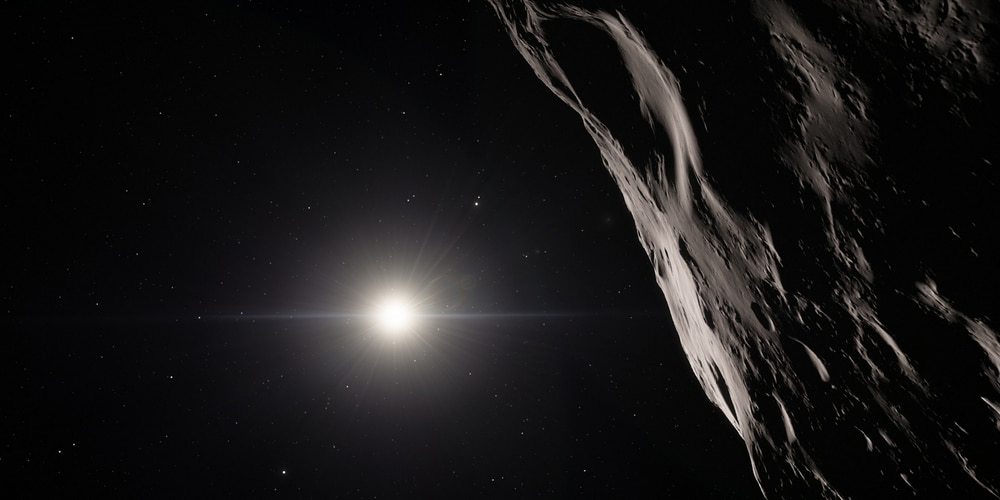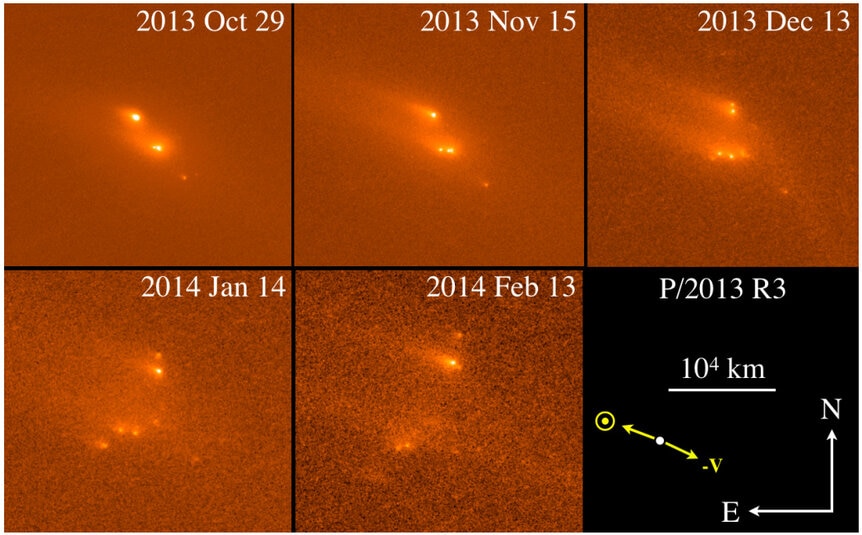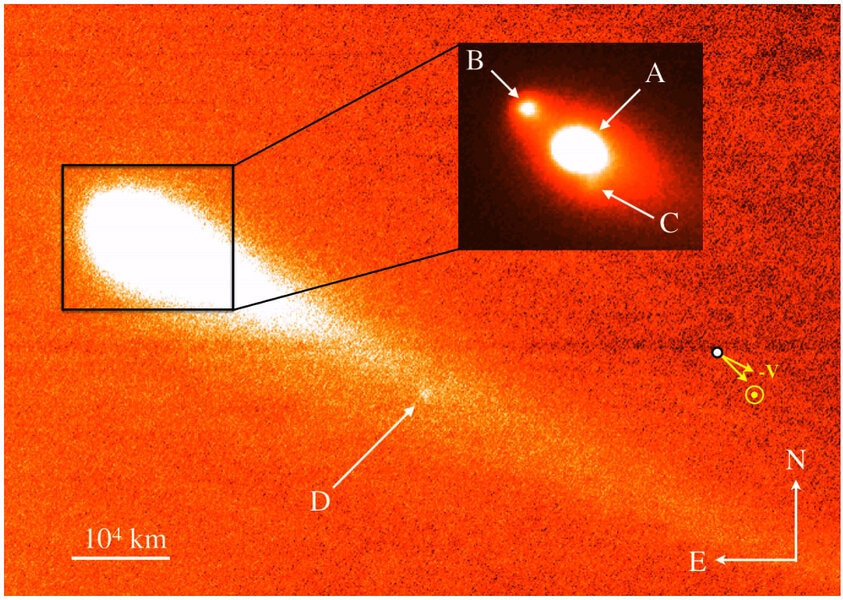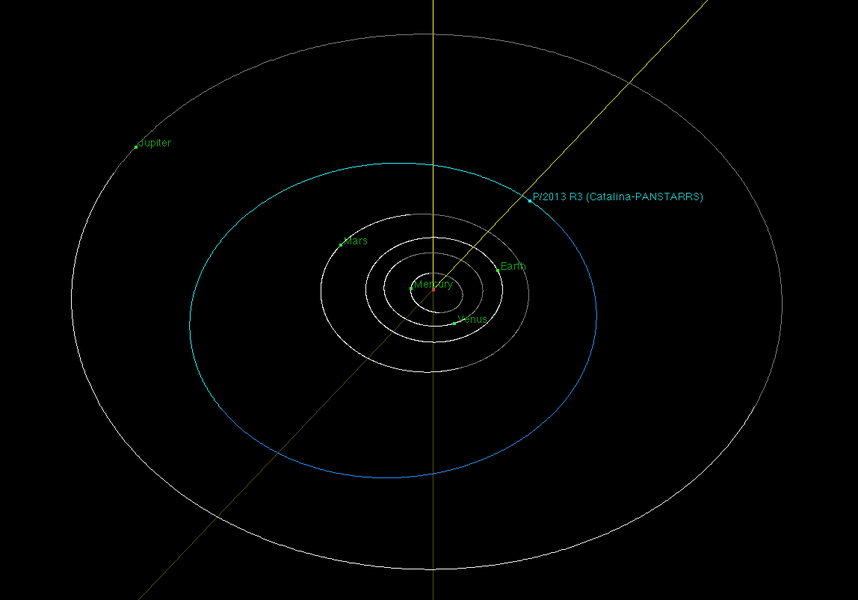Create a free profile to get unlimited access to exclusive videos, sweepstakes, and more!
In 2013, an asteroid exploded. Now we know why: It spun itself to death.

Sometime in August 2013, an asteroid exploded.
The government didn’t plant a bomb in it, and aliens didn’t zap it. This was a self-inflicted wound: The asteroid flung itself apart.
Asteroid P/2013 R3 —let’s call it R3 for short— was discovered in September 2013. Right away astronomers noticed something was up: It had at least two distinct components, and had what looked to be a tail!
That sounds more like a comet. Asteroids in general are rocky or metallic (or both), while comets have ice in them. As a comet nears the Sun, the ice turns into a gas and gets blown back by both the solar wind and the pressure of sunlight, creating a long tail.
But the orbit of R3 wasn’t comet-like. It was clearly in the main asteroid belt, the wide region of space between Mars and Jupiter. Everything about its orbit was asteroid-like, but its appearance was comet-like. What was it?
We’ve seen objects like this before. Sometimes an asteroid will collide another one, and the impact can shatter them and create a dust cloud that then behaves much like a comet tail.
New observations, though, clinch that this was not the case for R3. They show pretty conclusively that, instead, the asteroid spun itself to death. It was the victim of ... sunlight.
You heard me. Now, bear with me a sec. A very odd but important concept in physics is that even though light doesn’t have mass, it has momentum. When sunlight hits an asteroid, the asteroid warms up and re-radiates that heat away as infrared light. If the asteroid were perfectly spherical and non-rotating, the only effect would be to push the asteroid farther from the Sun (think of it like a very gentle breeze blowing on the asteroid, giving it a teeny tiny push).
But if the asteroid is spinning, or has an irregular surface (which, of course, they do; they have craters and pits and cracks and so forth), then that light it emits can be sent away at an angle, and this generates a small torque, causing the asteroid to spin faster. Over time, it can significantly change the asteroid’s rotation! That depends on many things, like the exact shape of the asteroid, how reflective it is, how close it gets to the Sun, and more. This process is called the YORP effect, due to it being dreamed up by scientists named Yarkovsky, O’Keefe, Radzievskii, and Paddack.
If asteroids were solid, the YORP effect could spin them up to pretty fast rotation rates. But many aren’t. Over billions of years, slow-speed collisions (or faster ones from tiny pebbles) can crack asteroids, causing them to have deep fractures. After a while, they’re essentially giant piles of rubble held together by their own gravity and a weak inter-molecular force called the van der Waals force.
So, imagine: P/2013 R3 probably started off as a fragment from a larger asteroid, thrown off in a collision long ago. Over time, it got pelted by smaller rocks, eventually becoming a weakly bound rubble pile. Even orbiting the Sun at a distance of roughly 500 million kilometers, sunlight took its toll. Calculations show that, over the course of about a million years, the YORP effect could have spun up R3 so much that it couldn’t hold itself together anymore. When it reached a rotation rate of roughly once every few hours, its gravity and van der Waals forces pulling inward couldn’t resist the centrifugal force pulling the pieces outward.
It flew apart.
The new observations of R3 show this to be the case. They used an armada of telescopes —Hubble, Keck, Magellan, and the VLT— to look at R3, and found 10 pieces moving apart in four distinct clumps. If the asteroid had suffered an impact, you’d expect a single, sharp event, with pieces flying outward. But the expansion rate of a mere 0.3 meters per second (less than walking speed!) is slower than an impact would generate.
More importantly, they found that the individual pieces, themselves, were breaking apart, and that is not what would likely happen upon an impact. Instead, if the asteroid spun itself up and flew apart, the individual pieces would also be spinning rapidly, and if they are weak as well, then they, too, will disintegrate. Several of the pieces were found to do this, with individual components appearing and disappearing over the time of the observations, indicating an extended event, not a sharp one.
There are other possibilities; if there were ice under the surface, then it could’ve been exposed to sunlight after the initial breakup, and the pressure from it turning into a gas cracked open the smaller pieces. That can happen after an impact as well, but again, the slow expansion speed argues against an impact.
There’s another interesting reason to think it was the YORP effect. Adding up the estimated sizes of the pieces gives an initial size of R3 of 400 meters. The math shows the YORP effect only takes a million years or so before breaking up a rock that size. But for an asteroid that size in the main belt, collisions big enough to disrupt it only occur on average every 150 million years. So it’s far more likely that this rock spun itself apart than suffered an impact.
We’ve seen asteroids and comets disrupted many times now. Some have indeed been whacked by an interplanetary interloper, but others look more like R3. These observations have shown us that what we used to think of as solid objects are really far more fragile, a valuable lesson for when we actually start visiting more asteroids and comets.
And it’s reinforced the thought that the solar system is a dynamic, ever-changing system, even after 4.6 billion years. That’s an exciting concept for me, because it means there will always be new things to discover even in our own cosmic backyard.
Tip o' the kinetic impactor to David Jewitt for answering my question about why the smaller components themselves are flying apart.





























